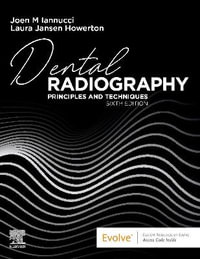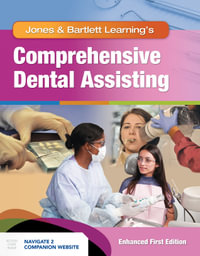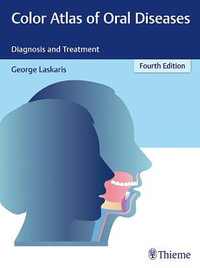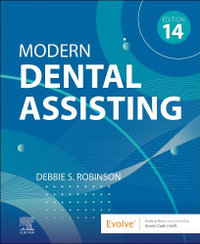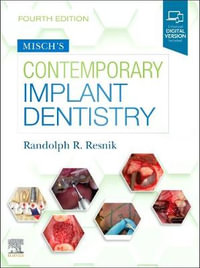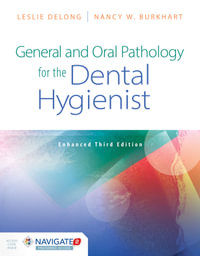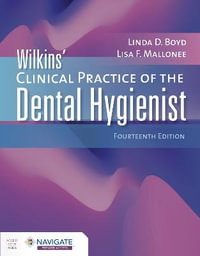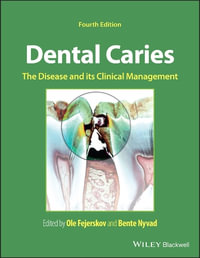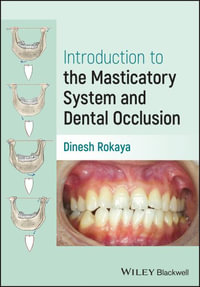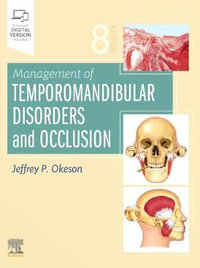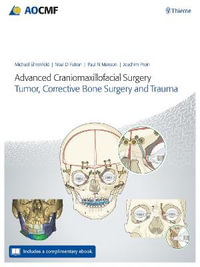
Caries Management - Science and Clinical Practice
By: Hendrik Meyer-Lueckel, Sebastian Paris, Kim R. Ekstrand
Hardcover | 20 March 2013
At a Glance
436 Pages
28.5 x 20 x 3
Hardcover
RRP $352.00
$209.25
41%OFF
or 4 interest-free payments of $52.31 with
orBeginning with patho-anatomic changes in the dental hard tissues, Dental Caries : Science and Clinical Practice goes on to cover non-invasive, minimally invasive, and more aggressive interventions based on each stage of the disease. From microbiology and histology to visual, tactile and radiographic diagnosis, risk assessment, preventive measures, and tooth preservation and treatment strategies, the book is packed with valuable clinical information for all dental practitioners.
Key Features:
- Succinctly covers the science behind the disease, with recommendations for treatments based on assessment starting at the microscopic level
- Written by a team of leading worldwide authorities on caries treatment and management and utilising the International Caries
- Detection and Assessment System (ICDAS) standard throughout
- Covers the newest treatment techniques, including adhesion technology, fissure sealing and infiltration, caries removal, tooth-coloured restorations, and more
- Demonstrates step-by-step caries procedures in striking, full-colour illustrations of adult and pediatric cases
- Offers the newest thinking on early prevention and behavioral changes in oral health promotion, including the role of diet and nutrition, biofilm management, fluoride use, population-based approaches, and more
Table of Contents XIII
Table of Contents
Part 1: Caries-Science
The Disease
1 Ecology of the Oral Cavity
Kim R. Ekstrand, Domenick T. Zero
Teeth............................... 4
Tooth Development and Tooth Emergence....... 4
Macromorphological Terms ................ 4
Occlusal Surfaces ....................... 4
Approximal Surfaces ..................... 7
The Cervical Enamel Line and the Roots ........ 7
Enamel.............................. 7
Chemical Composition and Structure of
Apatite Crystals ........................ 8
The Dentin-Pulp Organ ................... 9
The Cementum ........................ 10
Saliva .............................. 10
Saliva Production, Salivary Glands ........... 10
Function of Saliva ...................... 10
Pellicle ............................. 12
Hyposalivation ........................ 13
Changes in Teeth and Saliva with Aging ...... 13
Dental Plaque or Dental Biofilm? ........... 14
Classifying Oral Microorganisms............. 14
Colonization of the Mouth in the Newborn...... 15
Plaque: Development and Metabolic End Products. 15
Plaque Stagnation Areas .................. 16
Plaque Composition and Structure in
Stagnation Areas ....................... 17
2 Etiology and Pathogenesis of Caries
Peter Shellis
Microbiology of Caries................... 23
Chemistry of Dental Minerals .............. 25
Solubility, Dissolution, and Crystal Growth ...... 25
Minerals of Dental Tissues ................. 26
Fluoride and Calcium Phosphate Chemistry ...... 27
The Cariogenic Challenge................. 28
Chemistry of Caries .................... 33
Enamel Lesion Formation ................. 33
Dentin Lesion Formation.................. 34
Fluoride and Lesion Formation.............. 34
Remineralization and Lesion Arrest........... 34
Dental Erosion........................ 35
3 Histological and Clinical Appearance of Caries
Wolfgang Buchalla
Enamel Caries......................... 40
Location in the Teeth..................... 40
The White Spot Lesion ................... 42
Activity of White and Brown Spot Lesions ....... 42
Transmitted and Polarized Light Microscopy ..... 43
Transverse Microradiography ............... 46
Scanning Electron Microscopy............... 47
Transmission Electron Microscopy............ 48
Dentin Caries ......................... 48
Early Signs of Dentin Reaction .............. 50
Continuing Caries Progression into Dentin....... 51
Spread of Bacteria within Dentin ............ 52
Hardness of Carious Dentin ................ 52
Fluorescence Properties of Carious and
Healthy Dental Hard Tissue ................ 54
Caries of the Exposed Root ............... 55
Caries Arrest and Remineralization.......... 57
Correlation of Histology with Radiography
and Clinical Appearance of Caries........... 58
Erosion-a Noncarious Defect ............. 59
aus: Meyer-Lueckel u. a., Caries Management - Science and Clinical Practice (ISBN 9783131547118) © 2013 Georg Thieme Verlag KGXIV Table of Contents
4 Paradigm Shift in Cariology
Sebastian Paris, Hendrik Meyer-Lueckel
Scientific Paradigms .................... 65
How Paradigms Influence Our Clinical Approach. 65
The Speci?c Plaque Hypothesis .............. 65
The Ecological Plaque Hypothesis ............ 66
A Current Model of Caries ................ 66
Diagnostics and Epidemiology
5 Visual-Tactile Detection and Assessment
Kim R. Ekstrand, Stefania Martignon
General Remarks....................... 70
Histological and Clinical Features of Caries ..... 71
Coronal Caries Lesions.................... 71
Root Caries Lesions...................... 73
Caries Adjacent to Restorations .............. 74
Indices for Clinical Recording of Caries Lesions . . 74
Historical Perspective .................... 74
Correlation between Histology and
Clinical Severity: the ICDAS System .......... 76
Coronal Caries Lesions ................... 76
Root Caries Lesions ..................... 78
Caries Adjacent to Restorations ............. 78
Caries Activity Assessment ............... 79
Coronal Caries Lesions ................... 79
Root Caries Lesions ..................... 79
Caries Adjacent to Restorations ............. 80
The Visual Difference between Caries
and other Dental Hard Tissue Defects........ 82
6 Radiographic and Other Additional Diagnostic Methods
Rainer Haak, Michael J. Wicht
Radiographic Caries Diagnostics ............ 87
Context of Radiographic Caries
Detection ............................ 87
Validity and Reliability of Radiographic
Caries Detection........................ 88
Which Gold Standard? ................. 88
Sensitivity and Speci?city ............... 89
Reproducibility ...................... 89
Conventional and Digital Bitewing X-ray Imaging . . 89
Systems ........................... 89
Advantages of Digital Technologies ......... 89
Tuned-Aperture Computed Radiography and
Digital Volume Tomography ................ 89
Bitewings ............................ 91
Preparations ........................ 91
Taking Bitewing X-ray Photos ............. 91
Reproducible Adjustment................ 92
Documenting the Findings of Bitewing Images ... 93
Radiographic Extension and Clinical Findings
of Approximal Super?cial Lesions .......... 93
Evaluating Occlusal Surfaces ............. 94
The Mach Band E?ect.................. 95
Estimating the Probability of Caries
Progression ........................ 95
Determining the Radiologic Follow-up Interval ... 95
Relevant Factors ..................... 95
Special Considerations for Children and
Adolescents ........................ 96
Other Caries Diagnostic Methods ........... 97
Fiber-optic Transillumination............... 97
Methods Based on Fluorescence............. 97
Electrical Conductivity ................... 98
7 Caries Risk Assessment and Prediction
Cornelis van Loveren
The Dentist's Clinical Judgment............. 103
Crude Hit Rate of a Predictor .............. 103
Utilities of Predictors.................... 105
Objective Predictors .................... 108
ROC curve............................ 110
Cariogram............................ 110
Signs of Past Caries Experience ............. 113
Too Young to Have Past Caries
Experience........................... 114
Active versus Nonactive Lesions ............. 115
The Nexo Model....................... 116
aus: Meyer-Lueckel u. a., Caries Management - Science and Clinical Practice (ISBN 9783131547118) © 2013 Georg Thieme Verlag KGTable of Contents XV
8 Epidemiology of Caries and Noncarious Defects
Ulrich Schiffner
General Relevance of
Epidemiology ......................... 119
Study Types .......................... 119
Descriptive Epidemiology of Caries and
Noncarious Defects ..................... 120
Epidemiological Identi?cation of Caries......... 120
Indices for Coronal Caries.................. 121
Indices for Root Caries.................... 123
Other Indices for Public Health Needs.......... 124
Indices for Noncarious Defects .............. 124
Developmental Defects of the Dental
Hard Tissues ........................ 124
Acquired Defects of the Dental Hard Tissues ... 125
Occurrence and Distribution of Caries........ 125
Trends in Caries Epidemiology ............. 126
Global Considerations ................... 126
Children and Adolescents ................. 126
Association of Caries and Social Status....... 128
Adults and Seniors...................... 128
Root Caries........................... 129
Occurrence and Distribution of Noncarious
Defects ............................. 129
Developmental Defects................... 129
Acquired Defects of Enamel and Dentin ........ 130
9 From Diagnostics to Therapy
Sebastian Paris, Kim R. Ekstrand, Hendrik Meyer-Lueckel
From Diagnostics........................ 134
Diagnostics at the Individual Level............ 134
Diagnostics at the Tooth Level............... 134
How is Caries Diagnosed? ............... 134
The Truth About Caries ................. 135
Diagnostic Errors and Their Consequences..... 136
The Diagnostic Process ................. 137
Categories and Thresholds ............... 138
...to Therapy ......................... 139
Aim of Treatment....................... 139
Treatment Approaches ................... 140
Noninvasive Measures.................... 140
In?uencing the Bio?lm ................. 140
In?uencing Diet...................... 140
In?uencing Mineralization ............... 141
Microinvasive Measures .................. 141
Sealants........................... 141
In?ltration ......................... 141
(Minimally) Invasive Measures.............. 142
Restoration ........................ 142
Additional Measures .................. 142
Which Measures are Indicated at What Time? . . 142
Individual Level ....................... 142
Tooth Level .......................... 142
Therapeutic Options for Occlusal Caries ...... 143
Therapeutic Options for Approximal Caries.... 143
Therapeutic Options for Caries in Accessible
Smooth Surfaces ..................... 143
Therapeutic Options for Root Caries ........ 144
Noninvasive Therapy
10 Caries Management by Modifying the Bio?lm
Sebastian Paris, Christof Doerfer, Hendrik Meyer-Lueckel
Dental Plaque as a Biofilm ................ 147
Mechanical Biofilm Control................ 148
Correlation between Oral Hygiene and Caries .... 148
Self-Applied Mechanical Bio?lm Control ........ 148
Tooth Brushing ...................... 148
Interdental Hygiene ................... 153
Professional Tooth Cleaning ................ 154
Chemical Biofilm Control ................. 154
Chlorhexidine ......................... 155
Xylitol .............................. 155
Triclosan/Copolymer .................... 155
Essential Oil (Listerine)................... 156
Sodium Lauryl Sulfate ................... 156
Metal Ions ........................... 156
General Considerations................... 156
Biological Biofilm Control ................ 156
Vaccination .......................... 157
Probiotic Therapy ...................... 157
aus: Meyer-Lueckel u. a., Caries Management - Science and Clinical Practice (ISBN 9783131547118) © 2013 Georg Thieme Verlag KGXVI Table of Contents
11 Caries Management by Modifying Diet
Bennett T. Amaechi
Carbohydrates (Sugars) in the Caries Process ... 162
Conventional Sugars ..................... 162
Sugar Metabolism and Acid Production by
Cariogenic Microorganisms ................ 163
Intracellular Pathway .................. 163
Extracellular Pathway .................. 164
Factors Modifying the Role of Sugars in
Caries Development ..................... 165
Frequency of Sugar Intake ............... 165
Consistency of the Sugary Food............ 165
Amount of Sugar Intake................. 166
Thickness and Age of the Plaque ........... 166
Sugar Alcohols ........................ 167
Xylitol .............................. 167
Sorbitol ............................. 167
Maltitol ............................. 168
Intense Sweeteners ..................... 168
Other Food Components ................. 169
Proteins............................. 169
Fats ............................... 169
Food Preservatives...................... 169
Fresh Fruits, Vegetables,
and Other Dietary Components ............. 170
In?uence of Nutritional De?ciencies in the
Caries Process......................... 170
Population Groups with Raised Caries Risk
Due to Dietary Pattern .................. 170
Children ............................ 170
The Elderly .......................... 171
Dietary Guidance for Prevention of
Dental Caries......................... 171
Snacking Habit ........................ 172
Diet and Erosion ...................... 172
12 Caries Management by In?uencing Mineralization
Svante Twetman, Kim R. Ekstrand
What is Fluorine/Fluoride? ................ 177
Units of Measure ....................... 177
Fluoride in Our Surroundings .............. 177
Fluoride in Humans ..................... 177
Acute Toxicity ......................... 177
Fluoride Absorption and Distribution .......... 178
Fluoride in Teeth ....................... 179
Fluoride in Saliva and in Plaque.............. 179
From Mottled Enamel (Colorado Stained Teeth)
to Dental Fluorosis ..................... 180
Prevalence of Dental Fluorosis .............. 180
Effects of Water Fluoridation on Caries and
Dental Fluorosis: Pre- or Posteruption? ....... 182
How Fluoride Interacts with the Caries Process. . 183
Formation of Calcium Fluoride .............. 183
In?uence of Fluoride on Microbial Metabolism.... 184
Discussion of Classical Data ................ 184
Clinical Effectiveness of Fluoride ............ 185
Systemic and Topical Fluorides .............. 186
Community-Based Fluoride Application....... 186
Water Fluoridation (After Introduction of
Fluoride Toothpaste) .................... 186
Fluoridated Milk and Salt ................. 186
Individual Fluoride Application:
Professionally Applied Fluorides............ 186
Fluoride Varnishes...................... 186
Fluoride Solutions ...................... 187
Fluoride Gels ......................... 188
Individual Fluoride Application:
Self-Applied Fluorides ................... 188
Fluoride Toothpaste ..................... 188
Fluoride Mouth Rinses ................... 189
Fluoride Tablets and Chewing Gums .......... 189
Other Fluoride-Containing Products and Devices . . 189
Safety of Fluorides ..................... 189
Guidelines ........................... 190
Other Remineralization Agents ............ 190
CPP-ACP ............................ 190
13 Oral Health Promotion: Implementation of Noninvasive Interventions
and Health-Related Behaviors to Control the Caries Process
Hendrik Meyer-Lueckel, Sebastian Paris
Implementing Strategies of Prevention ....... 195
Prevention-What Does This Mean?........... 195
Why Do People Get Sick?.................. 195
A Little More Upstream: Setting-Approaches .... 196
Most Upstream: the Population-Based Common
Risk Factor Approach .................... 197
aus: Meyer-Lueckel u. a., Caries Management - Science and Clinical Practice (ISBN 9783131547118) © 2013 Georg Thieme Verlag KGTable of Contents XVII
Contemporary Strategies to Improve Oral Health 197
High-Risk versus Population-Based ........... 197
Noninvasive Interventions versus
Behavioral Change in Caries Prevention ........ 199
Is it Possible to Change Oral Health-Related
Behaviors? ........................... 199
De?nition ............................ 199
Models.............................. 199
Effectiveness of Contemporary Programs for
Caries Prevention ...................... 200
Role of Routine Serial Examinations in
Communities.......................... 200
Population-Based Approaches............... 200
Mass Campaigns to Change Behavior ........ 200
Fluoridated Water .................... 200
Fluoridated Salt ...................... 200
Approaches for Communities: Medical Options ... 201
Fluoride Tablets ..................... 201
Providing Free Fluoride Toothpaste ......... 201
Other Methods of Fluoride Application ...... 201
Approaches for Communities:
Oral Health Education ................... 202
Supervised Tooth Brushing .............. 202
Programs Relying on Oral Health Education ... 202
Setting-Approaches ................... 203
Approaches for Communities:
Combining Medical Options and Oral Health
Education ........................... 203
One-to-One Situation in Dental Practice........ 204
Adhesion
14 Basics in Adhesion Technology
Bart Van Meerbeek, Yasuhiro Yoshida
Evolution of Adhesive Technology in Generations 209
Early Days............................ 209
Breakthrough in Adhesion Technology ......... 210
No Separate Etching? .................... 210
Modern Classification of Adhesives .......... 210
Interaction with Hydroxyapatite-Based Tissues . . 212
Current Strategies for Bonding to Enamel ..... 212
Obstacles in Bonding to Dentin............. 214
Bonding to Dentin through the Etch-and-Rinse
Approach............................ 214
Shortcomings of Etch-and-Rinse Technology
and Potential Solutions .................. 215
Wet Bonding-How Moist is Wet? ............ 216
Rewetting ........................... 216
Nanoleakage.......................... 217
Recent Developments.................... 217
Bonding to Dentin through the Self-Etch
Approach ........................... 218
Nomenclature......................... 218
Mild Self-Etch Adhesives.................. 218
Mechanisms of Bond Degradation .......... 219
Bonding to Carious Dentin ............... 220
Clinical Performance.................... 220
Epilogue ............................ 221
Microinvasive Therapy
15 Fissure Sealing
Hafsteinn Eggertsson
Caries Prevalence on Occlusal Surfaces........ 226
The Sealant-Restoration Spectrum .......... 226
Epidemiological considerations .............. 227
Fissure Morphology..................... 228
The Fissure as Substrate for Resin Bonding..... 229
Cleaning of Fissures Prior to Sealant Placement . 230
Should Mechanical Preparation Be Routine? .... 230
Glass-Ionomer Sealants .................. 231
Preventive versus Therapeutic Sealants....... 231
Sealing over Caries? .................... 232
Moisture Control ...................... 233
Are Sealants Working Clinically? ........... 233
Sealant Failures and Maintenance........... 234
Cost-Effectiveness of Sealants ............. 234
Widespread Use of Sealants .............. 235
Conclusion .......................... 236
aus: Meyer-Lueckel u. a., Caries Management - Science and Clinical Practice (ISBN 9783131547118) © 2013 Georg Thieme Verlag KG16 Transfer of the Sealing Technique from the Occlusal to the Approximal Surface
Stefania Martignon, Kim R. Ekstrand
Transfer of the Sealing Technique from the
Occlusal to the Approximal Surface .......... 240
Clinical Procedure ...................... 240
Which Approximal Lesions Should Be Sealed? .... 240
Techniques for Approximal Sealing ........... 241
Sealing Procedure .................... 241
Patch Technique ..................... 241
Clinical Evidence ...................... 242
17 Caries In?ltration
Hendrik Meyer-Lueckel, Sebastian Paris
Development of Caries Infiltration........... 246
Biological Principles ..................... 246
Principle of Caries In?ltration ............... 248
Infiltration to Prevent Caries Progression...... 249
Clinical E?cacy of In?ltrating
Approximal Surfaces ..................... 250
Indications for Approximal Caries In?ltration..... 250
Clinical Use of Approximal Caries In?ltration .... 253
Follow-up for Approximal Caries ............ 253
Infiltration for Primarily
Esthetic Reasons ...................... 253
Scienti?c Studies ....................... 253
Indication ........................... 254
Follow-up ........................... 255
Invasive Therapy
18 How Much Caries Do We Have to Remove?
David D. J. Ricketts
Historical Perspective ................... 260
When to Remove Caries? ................. 261
Enamel Lesion ......................... 261
Enamel-Dentin Junction .................. 261
Cavitation............................ 261
Microbial Invasion of Dentin................ 262
Dentin Caries ......................... 263
Conventional Caries Removal .............. 264
Caries Removal at the Enamel-Dentin Junction . 264
Contemporary Caries Removal............. 265
Pulp-Dentin Complex................... 265
Deep Caries.......................... 265
Fissure Sealant Studies ................... 266
Stepwise Excavation Studies ............... 266
Systematic Review of the Literature .......... 268
Is ThereaNeed for Cavity Disinfection? ...... 268
19 Minimally Invasive Therapy with Tooth-Colored Direct Restorative Materials
Roland Frankenberger, Uwe Blunck
Indications for Restorative Therapy .......... 272
Posterior Teeth ........................ 272
Anterior Teeth ......................... 272
Cervical Area.......................... 273
Manifestations and Causes ............... 273
Technical Limits to Direct Restorative Materials ... 273
Materials for Tooth-colored
Direct Restorative Therapy................ 275
Overview ............................ 275
Glass-Ionomer Cements................... 275
Composites ........................... 275
Resin-Modi?ed Glass-Ionomer Cements ........ 276
Compomers........................... 276
Choosing Materials for Di?erent Indications ..... 277
Posterior Region...................... 277
Anterior Region ...................... 277
Cervical Defects ...................... 277
Preparation Instruments ................. 277
Excavation ........................... 277
Rotating Preparation .................... 277
Oscillating Preparation ................... 277
Rules for Minimally Invasive Preparation...... 278
General Preparation Rules................. 278
Access Forms ......................... 278
Anterior Region...................... 278
Posterior Region ..................... 278
ClassI(Fissures and Grooves) .............. 278
Class II (Approximal-Occlusal) .............. 279
Class III and Class IV (Anterior Tooth) ......... 279
Class V (Cervical Area) ................... 279
Problems in the Treatment of Cervical Defects . 279
Damage to the Neighboring Tooth in
Approximal Preparations................. 280
XVIII Table of Contents
aus: Meyer-Lueckel u. a., Caries Management - Science and Clinical Practice (ISBN 9783131547118) © 2013 Georg Thieme Verlag KGTable of Contents XIX
Clinical Experience with Minimally Invasive
Restorative Therapy .................... 280
Posterior Teeth ........................ 280
Anterior Teeth ......................... 281
Cervical Area.......................... 281
Repairing Restorations .................. 282
Treatment Decision
20 Decision-Making in Managing the Caries Process
Hendrik Meyer-Lueckel, Martin J. Tyas, Michael J. Wicht, Sebastian Paris
Fundamentals of Evidence-Based Dentistry..... 287
Treatment Recommendations ............... 288
Study Types .......................... 289
Shared Decision-Making.................. 289
The Doctor-Patient Relationship ............. 290
Including the Patient in the Decision-Making
Process............................ 290
Implementing Shared Decision-Making
in Practice.......................... 291
The Nine Steps of Shared
Decision-Making ....................... 291
Decisions, Decisions: Noninvasive, Microinvasive,
or (Minimally) Invasive?.................. 292
When in Rome, Do as the Romans Do.......... 292
Economic Consequences of the Time of Therapy... 293
Consequences on Therapy of "Philosophy"
in Cariology .......................... 293
Philosophy "Drill and Fill" ................. 293
A New Philosophy: "Heal and Seal"........... 293
Limits to Noninvasive Therapies............ 294
Micromorphological Aspects ............... 294
Clinical Considerations ................... 294
Radiographic Extension-Cavitation of the
Surface ........................... 294
Cavitation-Bio?lm ................... 295
Bio?lm-Caries Progression .............. 295
Speed of Caries Progression.............. 295
Limits to Microinvasive Therapies........... 296
Avoidance of Overtreatment ............... 297
The Problem of Undertreatment............. 297
Dentin Involvement................... 297
Residual Microorganisms ............... 297
Limits to Invasive Therapies............... 297
Decision Trees and Choice of Therapy ........ 299
Special Aspects in Children and the Young
21 How to Maintain Sound Teeth: an Individualized Population Strategy for Children and
Adolescents
Kim R. Ekstrand
The Multifactorial Concept of Caries ......... 306
Relevant Epidemiology .................. 307
Caries in the Primary Dentition.............. 307
Caries in the Permanent Dentition............ 307
Caries Progression Rate through the Enamel ..... 308
Eruption Time for Teeth in the Two Dentitions ... 308
Diagnostics of Caries in the Child Population .... 308
Individualized Population Strategy .......... 308
Documentation of caries experience......... 310
22 Individualized Caries Management in Pediatric Dentistry
Christian H. Splieth, Mohammad Alkilzy
Deciduous versus Permanent Teeth.......... 314
Anatomy............................. 314
Epidemiology ......................... 314
Function and Longevity ................... 314
Erupting Permanent Teeth ................. 315
Treatment Concepts in Deciduous Teeth....... 315
Buccal Surfaces ........................ 315
Occlusal Surfaces ....................... 316
Approximal Surfaces ..................... 316
Minimum Intervention in Permanent Teeth
in Children and Adolescents .............. 316
Occlusal Surfaces....................... 317
Sealants for Individuals at High Risk of Caries . . 318
Approximal Surfaces .................... 318
aus: Meyer-Lueckel u. a., Caries Management - Science and Clinical Practice (ISBN 9783131547118) © 2013 Georg Thieme Verlag KGXX Table of Contents
A Glimpse into the Future
23 Future Trends in Caries Research
Brian H. Clarkson, Agata Czajka-Jakubowska
Genetic Approaches..................... 321
Genomics-Caries Susceptibility ............. 321
Probiotics-Replacement Therapy with non-AcidProducing Bacteria ...................... 321
Gene Therapy-Repairing Salivary Glands ....... 321
Proteomics........................... 322
Antibody Engineering-Bacterial Adherence...... 322
Enzyme Recognition-Caries Activity Assessment . . 322
Tissue Engineering ..................... 322
The Dentin-Pulpal Complex ............... 322
Nanotechnology ...................... 323
Dendrimers-Antimicrobials/Antiadherents ..... 323
Antibacterial Nanoemulsions ............... 323
Degradable Microspheres-Remineralizing Agents . 323
"Smart" Materials-Responding to Physiological
and Nonphysiological Changes in the Oral Cavity. . 324
Synthetic Enamel ...................... 324
Part 2: Caries-Clinical Practice
24 Diagnostics, Treatment Decision, and Documentation
Sebastian Paris, Rainer Haak, Hendrik Meyer-Lueckel
Caries Diagnostics at the Patient Level........ 330
Determining the Risk Factors ............... 331
Caries Experience..................... 331
Sugar Consumption ................... 331
Frequency of Food Consumption ........... 331
Oral Hygiene ........................ 331
Fluoride Sources...................... 331
Salivary Flow........................ 331
Calculating the Caries Risk and Consequences .... 331
Caries Diagnostics at the Tooth Level......... 333
Visual-Tactile Examination ................ 333
Primary Caries ...................... 333
Caries Adjacent to Restorations ........... 333
Additional Diagnostic Tools ................ 335
Bitewing Radiographs and Fiberoptic
Transillumination .................... 335
Laser Fluorescence.................... 336
Endodontic Findings .................. 336
Additional Diagnostics ................... 336
Diagnosis and Planning a Therapy .......... 337
25 Minimal Interventional Treatment of Caries in the Permanent Dentition: Clinical Cases
Hendrik Meyer-Lueckel, Sebastian Paris, Christian A. Schneider, Leandro A. Hilgert, Soraya Coelho Leal
Case 1: A 30-year-old Woman with
Low-to-Medium Caries Risk................ 339
Hendrik Meyer-Lueckel, Sebastian Paris
Anamnesis ........................... 339
Clinical Findings (Tooth Level) .............. 339
Caries Risk Assessment (Individual Level) ....... 341
Diagnoses and Treatment Plan .............. 342
Individual Level ...................... 342
Tooth Level ......................... 342
Clinical Aspect at the End of the Treatment...... 348
Follow-up............................ 348
Case 2: A 22-year-old Man with
Medium Caries Risk..................... 351
Hendrik Meyer-Lueckel, Sebastian Paris
Anamnesis ........................... 351
Clinical Findings (Tooth Level) .............. 351
Caries Risk Assessment (Individual Level) ....... 352
Diagnosis and Treatment Plan............... 353
Individual Level ...................... 353
Tooth Level ......................... 353
Clinical Aspect at the End of the Treatment...... 360
Follow-up............................ 360
Case 3: Minimally Interventional
Anterior Restorations ................... 361
Christian A. Schneider, Hendrik Meyer-Lueckel
Anamnesis ........................... 361
Clinical Findings ....................... 361
Caries Risk ........................... 361
Diagnosis and Treatment Plan .............. 362
Individual Level ..................... 362
Tooth Level ........................ 362
Case 4: Infiltration to Mask Caries Lesions..... 367
Leandro A. Hilgert, Soraya Coelho Leal
Anamnesis ........................... 367
Clinical Findings ....................... 367
Caries Risk ........................... 368
Diagnosis and Treatment Plan .............. 368
Individual Level ..................... 368
Tooth Level ........................ 369
Clinical Aspect at the End of the Treatment ..... 370
Case 5: Stepwise Caries Excavation.......... 371
Hendrik Meyer-Lueckel, Sebastian Paris
aus: Meyer-Lueckel u. a., Caries Management - Science and Clinical Practice (ISBN 9783131547118) © 2013 Georg Thieme Verlag KGTable of Contents XXI
26 Minimal Interventional Treatment of Caries in Young Children: Clinical Cases
Vera Mendes Soviero, Soraya Coelho Leal, Christian Splieth, Mohammad Alkilzy
Case 1: A 6-Year-Old Boy with High Caries Risk . . 374
Mohammad Alkilzy, Christian Splieth
Anamnesis ........................... 374
Clinical Findings (Tooth Level) .............. 374
Caries Risk Assessment (Individual Level) ....... 375
Diagnosis and Treatment Plan............... 376
Individual Level ...................... 376
Tooth Level ......................... 377
Clinical Aspect at the End of the Treatment...... 380
Follow-up.......................... 380
Case 2: A 7-Year-Old Girl with
Medium Caries Risk..................... 381
Vera Mendes Soviero, Soraya Coelho Leal
Anamnesis ........................... 381
Clinical Findings (Tooth Level) .............. 381
Caries Risk Assessment (Individual Level) ....... 381
Diagnosis and Treatment Plan............... 383
Individual Level ...................... 383
Tooth Level ......................... 383
Follow-up............................ 385
Case 3: A 6-Year-Old Girl with
Very High Caries Risk ................... 385
Vera Mendes Soviero, Soraya Coelho Leal
Anamnesis ........................... 385
Clinical Findings (Tooth Level) .............. 385
Caries Risk Assessment (Individual Level)....... 386
Diagnosis and Treatment Plan .............. 388
Individual Level ..................... 388
Tooth level......................... 389
Clinical Aspect at the End of the Treatment ..... 393
Follow-up ......................... 393
Case 4: An 8-Year-Old Boy with
Medium Caries Risk .................... 394
Vera Mendes Soviero, Soraya Coelho Leal
Anamnesis ........................... 394
General Findings ....................... 394
Oral Health Indices ..................... 394
Clinical Findings (Tooth Level) .............. 394
Caries Risk Assessment (Individual Level)....... 397
Diagnosis and Treatment Plan .............. 397
Individual Level ..................... 398
Tooth Level ........................ 398
Monitoring and Recall ................... 399
27 Appendix
Dental examination form................. 401
Caries risk analysis ..................... 402
Treatment plan........................ 403
Index...................................................................... 405
ISBN: 9783131547118
ISBN-10: 3131547111
Published: 20th March 2013
Format: Hardcover
Language: English
Number of Pages: 436
Audience: General Adult
Publisher: Thieme Publishing Group
Country of Publication: DE
Dimensions (cm): 28.5 x 20 x 3
Weight (kg): 1.58
Shipping
| Standard Shipping | Express Shipping | |
|---|---|---|
| Metro postcodes: | $9.99 | $14.95 |
| Regional postcodes: | $9.99 | $14.95 |
| Rural postcodes: | $9.99 | $14.95 |
How to return your order
At Booktopia, we offer hassle-free returns in accordance with our returns policy. If you wish to return an item, please get in touch with Booktopia Customer Care.
Additional postage charges may be applicable.
Defective items
If there is a problem with any of the items received for your order then the Booktopia Customer Care team is ready to assist you.
For more info please visit our Help Centre.
